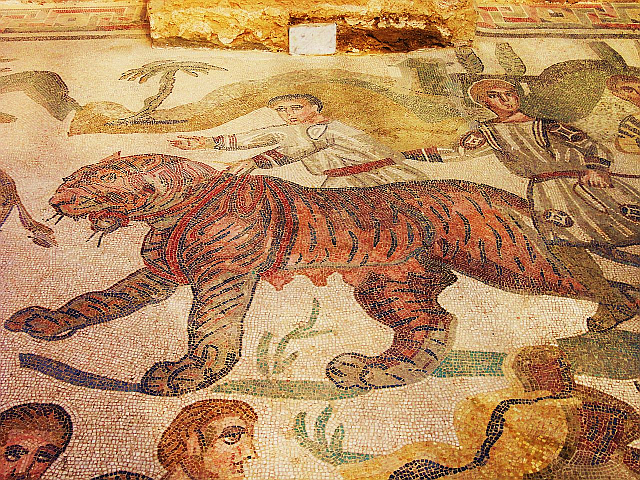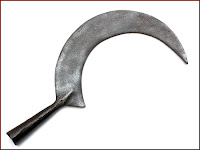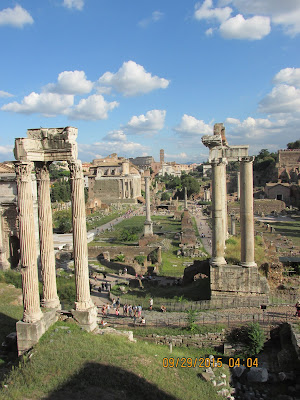A reasonable question to ask of
Paradiso 8 is why Charles Martel is the focus of the first encounter after hearing Beatrice's account of the upraising of man through the sacrifice of god + man in
Paradiso 7.
A second related question would be why at its outset, and then later in canto 8, does the poem perform an act of rational correction -- first noting the ancient world's error about the goddess Venus (1-10), later by translating Typhoeus into mere sulfur (70)?
Working through the remarkable web woven in
Paradiso 8 calls for more than even a lengthy blog post. I hope to be brief, but not cryptic.
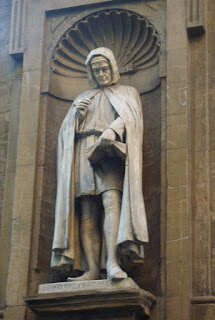 |
| Giovanni Villani |
In the
Nuova Cronica,
Giovanni Villani depicts Martel coming to Florence to meet his father, King Charles II, who was returning from France after a complex diplomatic mission:
Book 8.13: . . . come to meet him was Charles Martel . . . king of Hungary, with his company of 200 knights with golden spurs, French and Provençal and from the Kingdom, all young men, invested by the king with habits of scarlet and dark green, and all with saddles of one device, with their palfreys adorned with silver and gold, with arms quarterly, bearing golden lilies and surrounded by a bordure of red and silver, which are the arms of Hungary. And they appeared the noblest and richest company a young king had ever had with him. And in Florence he abode more than twenty days, awaiting his father, King Charles, and his brothers; and the Florentines did him great honour, and he showed great love to the Florentines, wherefore he was in high favour with them all. (Italian edition)
It is this Martel, now one of the
lumi divini -- moving faster than lightning in a dance begun by the
alti Serafini -- who welcomes the pilgrim with joyous hospitality, as if he were the grand seigneur of the mansion of Venus.
Martel warmly greets Dante with the first line of the poet's canzone:
Voi che 'ntendendo il terzo ciel movete
Curiously the line concerns the very sphere to which Dante has just arrived. The poet realizes that he has been recognized, but Martel is concealed, nested in the happiness that shines about him. He then discloses his identity, using the rivers that carve out the lands to which his royal bloodlines made him heir.
Interestingly, Martel's name in Italian, Martello, means "hammer," and throughout the canto Charles speaks of moving forces that shape things. As the rivers shape the lands he seemed destined to rule, the streaming intelligences of the spheres shape the human natures that are found in abundance on earth, not grouped by bloodline. Once again, as has been the case consistently in the
Paradiso, natural forces -- whether purely natural like rivers, or "super" natural like angelic intelligence, are depicted at work. Nature is a vast system and order, but not always genetic.
This sense of powerful intelligences embodied in vast bodies is manifest when Martel says:
Lo ben che tutto il regno che tu scandi
volge e contenta, fa esser virtute
sua provedenza in questi corpi grandi.
The Good which all the realm thou art ascending
Turns and contents, maketh its providence
To be a power within these bodies vast;
Martel is about to explain how it is that bitter fruit can come from sweet seed. That is, how natural filiation cannot explain large differences in nature between parent and child.
The Good puts its providential power into this giant machine of heavenly forces, but strangely its provision -- literally, fore-seeing -- is not looking at specific individuals, nor is it guided by some preconceived plan.
Revolving Nature, which a signet is
To mortal wax, doth practise well her art,
But not one inn distinguish from another; (8.127-29)
It rays down dispositions, gifts, talents and abilities not according to DNA, nor due to some destiny, but abundantly so that those who are formed with such gifts are left entirely free to make what they will of them.
Yet it's all foreseen:
And not alone the natures are foreseen
Within the mind that in itself is perfect,
But they together with their preservation.
For whatsoever thing this bow shoots forth
Falls foreordained unto an end foreseen,
Even as a shaft directed to its mark.
What we have here borders on antinomy - a strong description of
provedenza aiming at and hitting a foreseen goal, yet coupled with a strong affirmation of free will on the part of the one who is nonetheless shaped by the rays of heavenly gifts. There is high tension between these two realms. The
providenza that fore-sees somehow doesn't see the particular beneficiary. (It's as if a gear in the machine had slipped - can Providence be blind?)
Perhaps the key to the puzzle is that these are gifts. If one is "gifted," one is usually happy to use one's gift. They are freely given, and carry no contractual commitment on the part of the recipient to reciprocate with service or work of equal value. The heavens are always sending these gifts with no specific end user, no price tag, no fine print. It is a vision of loving generosity so vast as to make anyone happy.
Charles is certainly happy, as we've noted. Which is why it is singularly crucial to note that this Charles Martel lived but 24 years, and never sat on any throne to which he was legitimately entitled except a portion of Croatia. His very name echoes the "real"
Charles Martel, the multi-gifted 8th century ruler and administrator who laid the groundwork of the Carolingian empire, as Dante's infelicitous Charles Martel of Anjou did not.
Charles's claim to the Hungarian throne was rejected by the land's nobles, and he died too soon -- in 1295 from plague -- to come into his own in Naples. As we learn at the beginning of
Paradiso 9, the succession of his own child to the kingdom of Naples was pushed aside by his brother Robert. In USian parlance, Charles would be termed a "loser."
He was gifted with the best qualities of a ruler, coupled with the legitimate expectation of earthly power, yet his life
(vita) on earth was too brief for any of this giant promise -- clearly seen by Dante during Charles' splendid visit to Florence in 1294 -- to be realized. Martel is barely a
footnote in the annals of the kings of Hungary, Provence, or Naples, (regardless of what sort of contenda he coulda been).
In essence, Martel replicates in his own life the sharp antinomy he just described: the contradiction between the rational order of providence and the hit-or-miss errancy of Earth. With his hopes dashed and all promise of political creation and royal primogeniture lost, Charles certainly had all reason to stew in his bile beans. Dante no doubt saw an alternate version of his own
vita in the young king's fate.
But we find no eulogy, no elegy, no Virgilian threnody. Charles is the happiest man we've met so far, which might come as a shock -- in fact, it should. This is the strange tension of canto 8.
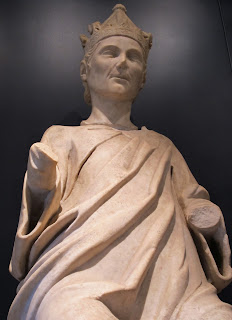 |
| Henry VII of Luxembourg |
Martel speaks of the shaping of lands and souls, and incarnates the utter dissolution of human and divine potential. He could be angry at his brother, he could curse God and die, he could "whinge," as our group surely expected him to be doing the other day. We can be fairly sure that Dante, learning of the death of his young friend, and, then in 1313, receiving news that
Henry VII -- in whom he'd placed all his hopes for a renewed Empire -- had also perished, was sorely tempted to emit a few expletives.
The spectacle of hopes dashed is powerfully seductive. Who can continue to place faith in Providence when so many good people fall?
Let's remember how we first saw Charles -- he was compared to a spark in a flame, then to a note moving away from and back to a
cantus firmus, then to a dancer moving at the speed of light, in a dance begun by the highest beings of creation -- then, when he speaks, he turns into a warm, friendly, luminous human being.
Combine that with the canto's emphasis upon the power of Reason to strip myths that can rule our souls, which otherwise might worship mad eros, or fear angry Typhoeus. Reason opposes the mythic notion that we are driven by irrational powers. For Dante and Martel, Reason is built into the fabric of things, but earthly things are subject to all manner of contingency, freedom, and derangement.
Martel sits -- one could say he is broken -- at the point at which the rational intelligences of the Good that turns and contents all things encounter the random, senseless, fallen sub-lunar world. The creature raised up by the Word of God as described in canto 7 has no easy time of it. Our best efforts often go to naught, despite the generosity and good will of the Good. It's enough to drive a good man to distraction.
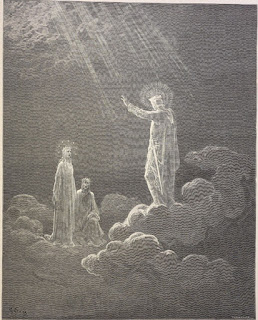 |
| Charles Martel - Dore |
Many would say Charles Martel never really lived. How is it that he's swathed in happiness like a creature in its own silk?
Charles offers us a clue, when he says (quoted in English above):
La circular natura, ch'è suggello
a la cera mortal, fa ben sua arte,
ma non distingue l'un da l'altro ostello. (8.127-29)
Nature is the seal, we are mortal wax --
cera mortal. At the end, the wax is no longer there -- we are literally
sine-cera. To be sincere is to stand free from all mortal traces. The intelligences shaping the world through the gifts of the Good do not distinguish one transient hostel from another (
ostello rhymes with
martello). Charles is the gracious host wherever he resides.
Martel is at a place where he might regret that his brother Robert isn't right for the role he's playing in Naples. But Charles lives at another
ostello, one where nothing of his stunted earthly life can touch the contentment provided by the Good that turns the Kingdom. His words speak of joy; his alacrity, his voice, and his royal friendship embody the intelligent love of the third sphere -- love on a scale that could provide for nations and empires.
Charles not only lived, but lives. That's affirmed by Dante in
Paradiso 9, when Charles, as he turns toward the sun, is not
ombra (shade), nor
lume (light), nor
anima (soul), but life --
vita:
E già la vita di quel lume santo
rivolta s'era al Sol che la rïempie,
come quel ben ch'a ogne cosa è tanto. (9.7-9)
And of that holy light the life already
Had to the Sun which fills it turned again,
As to that good which for each thing sufficeth.



